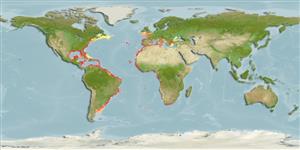Environment: milieu / climate zone / depth range / distribution range
Ökologie
seewasser; brackwasser riff-verbunden; tiefenbereich 1 - 100 m (Ref. 26999). Subtropical; 52°N - 45°S, 98°W - 36°E
Eastern Atlantic: English Channel to Angola, including the Mediterranean, Madeira, and the Azores. Western Atlantic: Canada (Ref. 5951) to Massachusetts, USA and the Gulf of Mexico to Argentina.
Length at first maturity / Size / Gewicht / Alter
Maturity: Lm 19.5 range ? - ? cm
Max length : 50.0 cm SL Männchen/unbestimmt; (Ref. 6544); common length : 38.0 cm TL Männchen/unbestimmt; (Ref. 3397); max. veröff. Gewicht: 1.8 kg (Ref. 4699)
Rückenflossenstacheln (insgesamt): 7; Rückenflossenweichstrahlen (insgesamt): 8; Afterflossenstacheln 0; Afterflossenweichstrahlen: 6. Pectoral fin very large and fan-like, with front 6 rays separated as small lobe (Ref. 26938).
Found on sand, mud or over rocks in sandy areas, exploring the bottom with the free part of the pectoral fins (Ref. 6544). Feeds primarily on benthic crustaceans, especially crabs, clams and small fishes. Neither anterolateral glandural groove nor venom gland is present (Ref. 57406).
Life cycle and mating behavior
Geschlechtsreife | Fortpflanzung | Ablaichen | Eier | Fecundity | Larven
Eschmeyer, W.N. and L.J. Dempster, 1990. Dactylopteridae. p. 690-691. In J. C. Quero, J. C. Hureau, C. Karrer, A. Post, and L. Saldanha (eds.) Check-list of the fishes of the eastern tropical Atlantic (CLOFETA). JNICT, Lisbon; SEI, Paris; and UNESCO, Paris. Vol. 2. (Ref. 10782)
IUCN Rote Liste Status (Ref. 130435)
Bedrohung für Menschen
Harmless
Nutzung durch Menschen
Fischereien: weniger kommerziell; Sportfisch: ja; Aquarium: Kommerziell
Tools
Zusatzinformationen
Download XML
Internet Quellen
Estimates based on models
Preferred temperature (Ref.
123201): 13.3 - 27.8, mean 23.9 °C (based on 1072 cells).
Phylogenetic diversity index (Ref.
82804): PD
50 = 1.0078 [Uniqueness, from 0.5 = low to 2.0 = high].
Bayesian length-weight: a=0.00977 (0.00739 - 0.01292), b=2.98 (2.90 - 3.06), in cm total length, based on LWR estimates for this species (Ref.
93245).
Trophic level (Ref.
69278): 3.7 ±0.5 se; based on diet studies.
Generation time: 3.7 ( na - na) years. Estimated as median ln(3)/K based on 1
growth studies.
Widerstandsfähigkeit (Ref.
120179): mittel, Verdopplung der Population dauert 1,4 - 4,4 Jahre. (Preliminary K or Fecundity.).
Fishing Vulnerability (Ref.
59153): Moderate vulnerability (37 of 100).
Nutrients (Ref.
124155): Calcium = 30.8 [13.6, 95.1] mg/100g; Iron = 0.647 [0.323, 1.546] mg/100g; Protein = 19.4 [17.9, 20.8] %; Omega3 = 0.361 [0.152, 1.044] g/100g; Selenium = 20.1 [9.0, 46.1] μg/100g; VitaminA = 30.2 [9.0, 104.6] μg/100g; Zinc = 0.79 [0.52, 1.21] mg/100g (wet weight);
